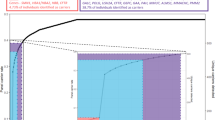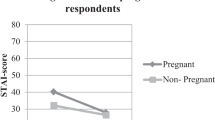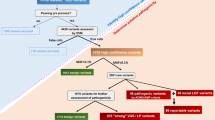Abstract
The expansion of newborn screening (NBS) is increasing the generation of incidental results, notably carrier results. Although carrier status is generally understood to be clinically benign, concerns persist that parents may misunderstand its meaning, with deleterious effects on children and their families. Expansion of the NBS panel in Ontario, Canada in 2006 to include sickle cell disorders drew attention to the policy challenge of incidental carrier results. We conducted a study of consumer and provider attitudes to inform policy on disclosure. In this paper, we report the results of (i) qualitative interviews with health-care providers, advocates and parents of carrier infants and (ii) focus groups with new parents and individuals active with the sickle cell community. Lay and provider participants generally believed that carrier results were clinically insignificant. However, some uncertainty persisted among lay consumers in the form of conjecture or doubt. In addition, consumers and advocates who were most informed about the disease articulated insistent yet dissonant claims of clinical significance. Meanwhile, providers referenced research knowledge to offer an equivocal assessment of the possibility and significance of clinically symptomatic carrier status. We conclude that many interpretations of carrier status are in circulation, failing to fit neatly into the categories of ‘clinically significant’ or ‘benign.’ This creates challenges for communicating clearly with parents – challenges exacerbated by inconsistent messages from screening programs regarding the significance of sickle cell carrier status. Disclosure policy related to incidentally generated infant carrier results needs to account for these complex realities.
Similar content being viewed by others
Log in or create a free account to read this content
Gain free access to this article, as well as selected content from this journal and more on nature.com
or
References
U.S. Preventive Services Task Force: Screening for Sickle Cell Disease in Newborns: U.S. Preventive Services Task Force Recommendation Statement. Rockville: Agency for Healthcare Research and Quality, 2007.
National Heart Lung and Blood Institute: The Management of Sickle Cell Disease, National Institutes of Health. Division of Blood Diseases and Resources, 2002, p 206.
Sears D : The morbidity of sickle cell trait: a review of the literature. Am J Med 1978; 64: 1021–1036.
Kark JA, Ward FT : Exercise and Hemoglobin S. Semin Hematol 1994; 31: 181–225.
NHS Sickle Cell and Thalassaemia Screening Programme: Results of Newborn Blood-Spot Screening: Carrier of a Sickle Cell Gene – Sometimes Called Trait Hb AS, 2007.
American College of Medical Genetics: Newborn Screening Act Sheets and Confirmatory Algorithms, 2006.
Oliver S, Dezateux C, Kavanagh J, Stewart R, Lempert T : Disclosing to parents newborn carrier status identified by routine blood spot screening. Cochrane Database Syst Rev 2004. Issue 4. Art. No.: CD003859. DOI:10.1002/14651858.CD003859.pub2.
Ameisen J-C, Fischer A, Grimfeld A, Kordon C, Le Coz P, Lepesant J-A : Ethical Issues Arising out of the Delivery of Neonatal Genetic Information after Screening for Genetic Disorders (the examples of cystic fibrosis and sickle-cell disease). National Consultative Ethics Committee for Health and Life Sciences, 2007, p 21.
Streetly A, Clarke M, Downing M et al: Implementation of the newborn screening programme for sickle cell disease in England: results for 2003–2005. J Med Screen 2008; 15: 9–13.
Hayeems R, Bytautas J, Miller FA : A systematic review of the effects of disclosing carrier results generated through newborn screening. J Genet Couns 2009; 17: 538–549.
Moran J, Quirk K, Duff AJ, Brownlee KG : Newborn screening for CF in a regional paediatric centre: the psychosocial effects of false-positive IRT results on parents. J Cyst Fibros 2007; 6: 250–254.
Miller F, Hayeems R, Carroll J et al: Consent for newborn screening: the attitudes of health care providers. Public Health Genomics (in press).
Kitzinger J : Qualitative research: introducing focus groups. Br Med J 1995; 311: 299.
Richardson L : Writing: a method of inquiry; in Denzin NK, Lincoln YS (eds): Handbook of Qualitative Research, 2nd edn Thousand Oaks, CA: Sage, 2000, pp 923–949.
Charmaz K : Grounded theory: objectivist and constructivist methods; in Denzin NK, Lincoln YS (eds):: Handbook of Qualitative Research, 2 edn Thousand Oaks, CA: Sage Publications, 2000, pp 509–535.
Addison RB : A grounded hermeneutic editing approach; in: Crabtree BF, Miller WL (eds): Doing Qualitative Research, 2nd edn Thousand Oaks, CA: Sage, 1999, pp 145–161.
Lewis S, Curnow L : Parental attitudes to the identification of their infants as carriers of cystic fibrosis by newborn screening. J Paediatr Child Health 2006; 42: 5.
Waisbren SE, Albers S, Amato S et al: Effect of expanded newborn screening for biochemical genetic disorders on child outcomes and parental stress. JAMA 2003; 290: 2564–2572.
Green M : Vulnerable child syndrome and its variants. Pediatr Rev 1986; 8: 75–80.
Fullwiley D : Biosocial suffering: order and illness in Urban West Africa. BioSocieties 2006; 1: 421–438.
Lucas S, Mason D, Mason M, Weyman D : A Sickle Crisis? A Report of the National Confidential Enquiry into Patient Outcome and Death. London, 2008.
Wailoo K : Dying in the City of the Blues: Sickle Cell Anemia and the Politics of Race and Health. University of North Carolina Press, 2001.
Parker H, Qureshi N, Ulph F, Kai J : Imparting carrier status results detected by universal newborn screening for sickle cell and cystic fibrosis in England: a qualitative study of current practice and policy challenges. BMC Health Serv Res 2007; 7: 203.
Acknowledgements
We are indebted to our research participants, and thank the Ontario Ministry of Health and Long-Term Care for project funding (06358). FA Miller is supported by a New Investigator Award from CIHR (80495). RZ Hayeems is supported by a CADRE Postdoctoral Fellowship from CIHR and CHSRF. J Little holds a Canada Research Chair in Human Genome Epidemiology. J Carroll is supported by the Sydney G. Frankfort Chair in Family Medicine. Sponsors' support does not imply endorsement of the conclusions, for which the authors retain sole responsibility.
Author information
Authors and Affiliations
Corresponding author
Rights and permissions
About this article
Cite this article
Miller, F., Paynter, M., Hayeems, R. et al. Understanding sickle cell carrier status identified through newborn screening: a qualitative study. Eur J Hum Genet 18, 303–308 (2010). https://doi.org/10.1038/ejhg.2009.173
Received:
Revised:
Accepted:
Published:
Issue date:
DOI: https://doi.org/10.1038/ejhg.2009.173
Keywords
This article is cited by
-
Health services use by children identified as heterozygous hemoglobinopathy mutation carriers via newborn screening
BMC Pediatrics (2021)
-
A qualitative study to explore how professionals in the United Kingdom make decisions to test children for a sickle cell carrier status
European Journal of Human Genetics (2016)
-
Parents’ responses to receiving sickle cell or cystic fibrosis carrier results for their child following newborn screening
European Journal of Human Genetics (2015)
-
Obstetrician-Gynecologists’ knowledge of sickle cell disease screening and management
BMC Pregnancy and Childbirth (2014)
-
Reply to Ross' commentary: Reproductive benefit through newborn screening: preferences, policy and ethics
European Journal of Human Genetics (2012)



